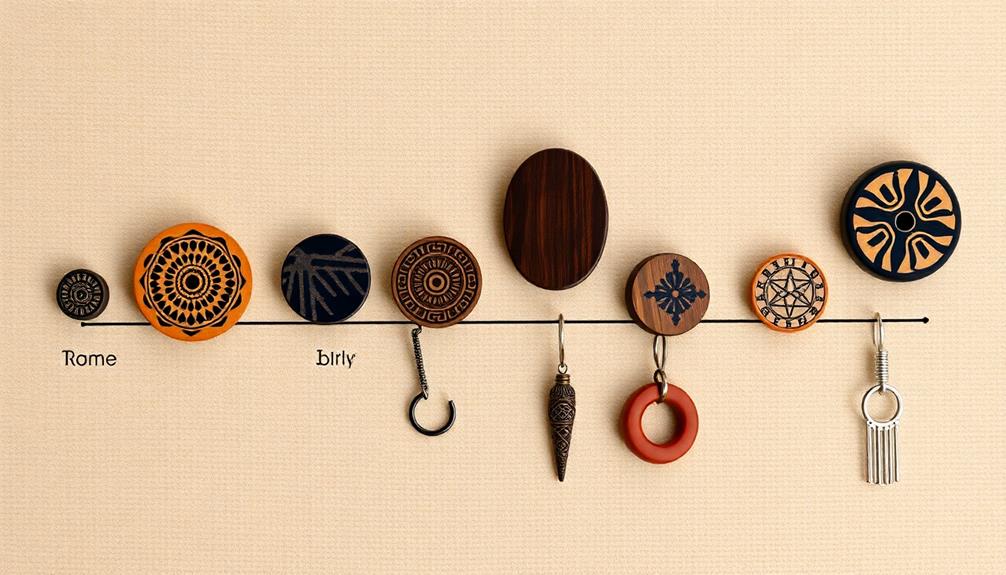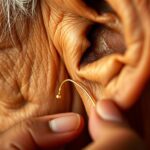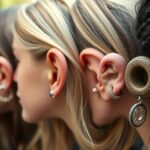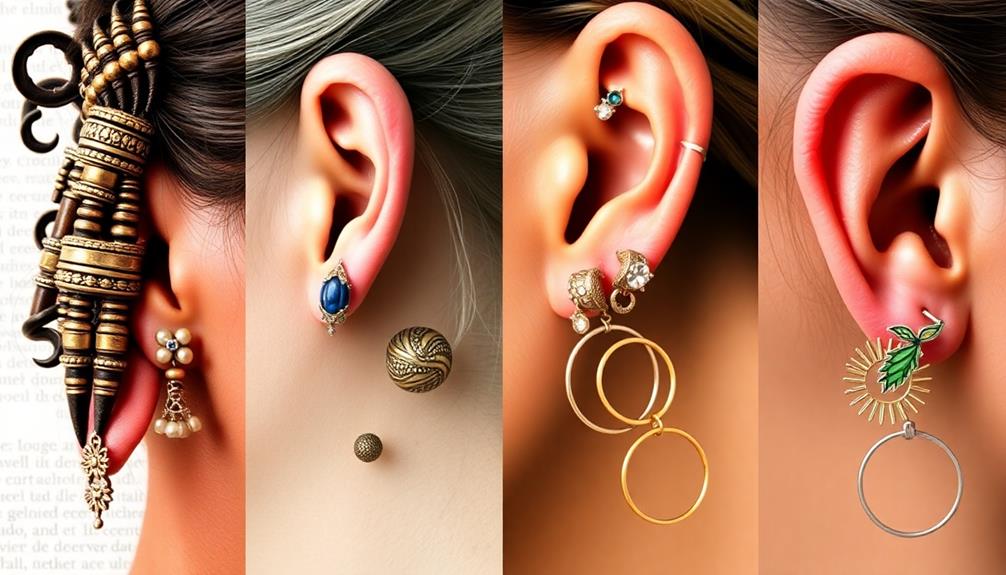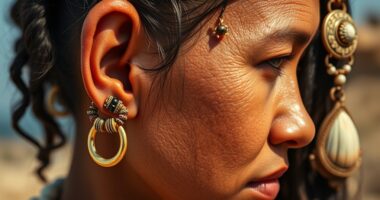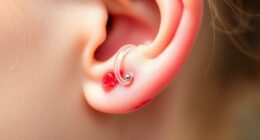Ear gauges have evolved greatly throughout history, showcasing diverse cultural practices. You'll find evidence of ear stretching as far back as 3300 BCE with Ötzi the Iceman. In ancient Egypt, ear stretching signified social status, while Mayans and Aztecs linked larger gauges to spirituality. Modern practices prioritize safety, using biocompatible materials and gradual stretching techniques to minimize risks. Today, ear gauges serve as a form of personal expression, influenced by celebrities and social media. You might be intrigued to learn how these practices have shaped modern aesthetics and health considerations in the world of body modification.
Key Takeaways
- Ear stretching dates back to 3300 BCE, with significant cultural practices in ancient civilizations like Egyptians, Mayans, and Maasai.
- The introduction of the American Wire Gauge in 1857 standardized ear gauge measurements, facilitating global commerce in body jewelry.
- Modern practices emphasize safe, gradual stretching techniques and the use of biocompatible materials to enhance comfort and reduce health risks.
- Ear gauges serve as a form of personal expression, with contemporary trends influenced by celebrity endorsements and social media visibility.
- Historical figures, such as Buddha and King Tutankhamun, showcased the cultural significance of ear gauges as symbols of status, wisdom, and spirituality.
Historical Origins of Ear Stretching
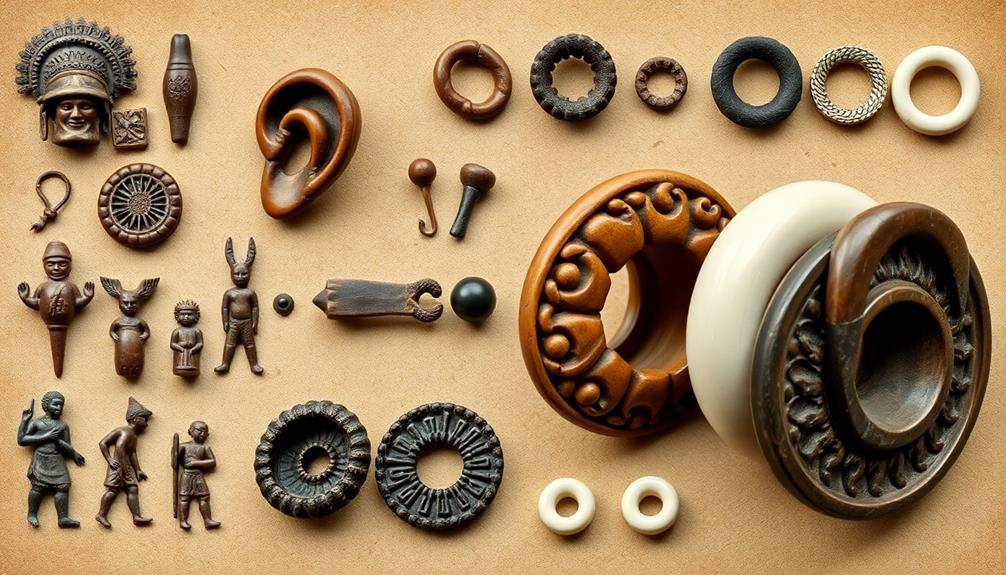
Ear stretching has a fascinating history that dates back thousands of years. You might be surprised to learn that practices can be traced as far back as 3300 BCE, with archaeological findings revealing that Ötzi the Iceman had ear piercings measuring approximately 8mm (00g).
Historically, ear stretching has been more than just a trend; it held significant cultural importance. The ancient Egyptians, including iconic figures like King Tutankhamun, popularized this practice as a symbol of social status and cultural significance.
Various civilizations, such as the Mayans and Aztecs, also embraced ear stretching as part of their spiritual and social traditions. They often used larger ear gauges to signify social distinctions or military ranks.
In Africa, the Maasai tribe views stretched ears as symbols of wisdom and maturity, showcasing the practice's deep roots across different societies.
The evolution of body modification culture took a significant turn in 1857 when a standardized measurement system for body jewelry was introduced—the American Wire Gauge (AWG). This development helped facilitate the international commerce of ear stretching practices, marking a pivotal moment in its history.
Cultural Significance Across Civilizations
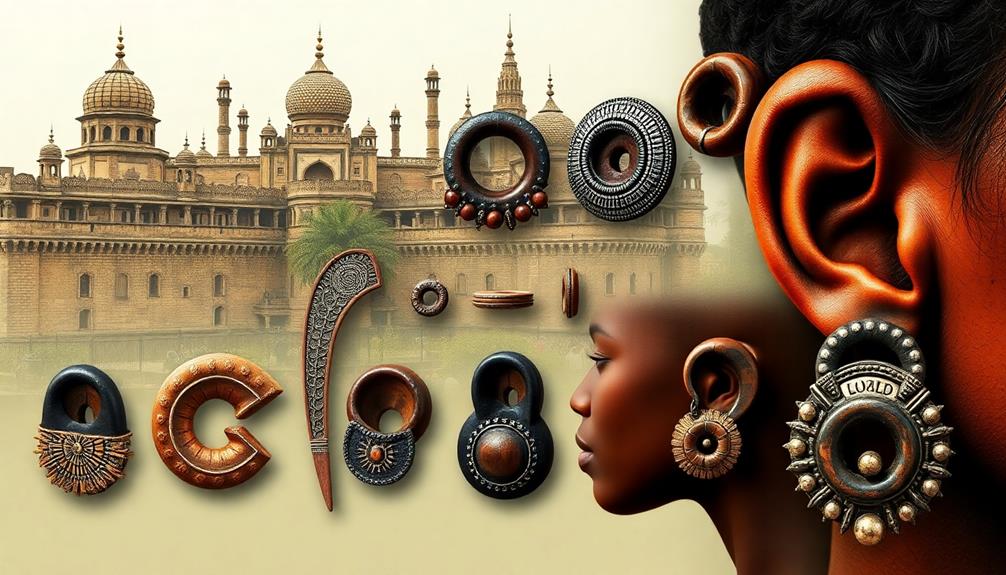
Throughout history, body modifications like ear stretching have carried deep cultural significance across various civilizations. For many ancient tribes, earlobe stretching wasn't just a fashion statement; it was a reflection of societal norms and beliefs. The Egyptians, for instance, used elongated earlobes as a status symbol, as evidenced by King Tutankhamun's golden death mask.
Similarly, the Mayans and Aztecs viewed ear stretching as a spiritual practice, believing that larger gauges helped individuals connect to the divine. In regions rich with natural resources, such as abundant wild edibles, body modifications often mirrored the local environment and the peoples' relationship with nature.
In Africa, the Maasai tribe regards ear plugs as markers of wisdom and maturity, illustrating how body modification signifies important life stages. The Dayak people of Borneo take this further, stretching their ears to shoulder length to showcase beauty and cultural identity, highlighting traditional methods that have been preserved over generations.
Even in ancient Celtic culture, ear spools were common, demonstrating how ear stretching served to distinguish tribal identities. Across these diverse societies, ear stretching remains a powerful expression of identity, status, and cultural heritage, proving that body modification is more than skin deep; it's an essential part of human history.
Notable Figures in Ear Gauge History
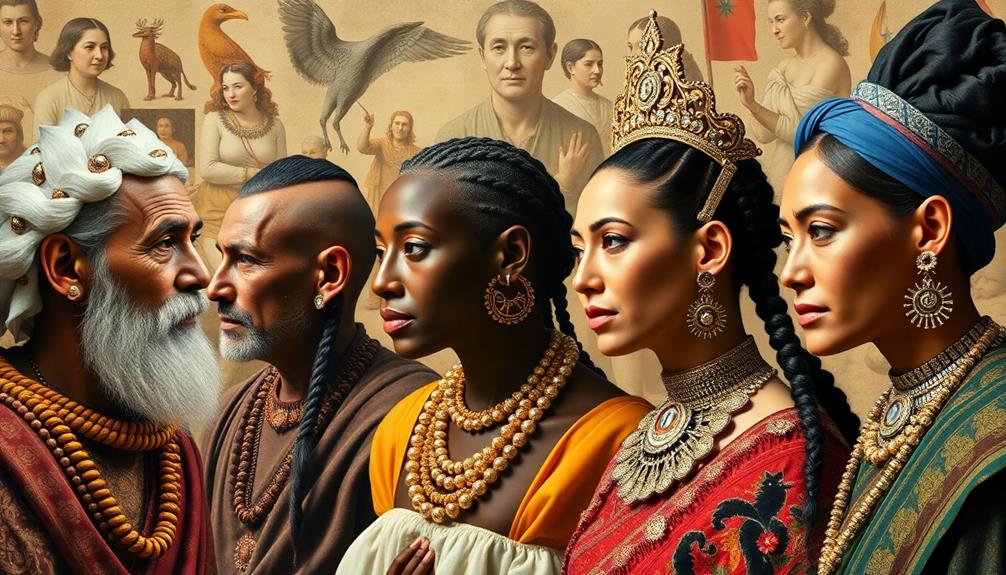
Body modifications have always been intertwined with cultural identity, and ear gauges are no exception. Throughout history, notable figures have embraced ear stretching, showcasing its deep-rooted significance in various cultures. Here are a few key examples:
- Buddha: His elongated earlobes symbolize wisdom and enlightenment.
- King Tutankhamun: Wore elaborate ear jewelry, reflecting ancient Egyptian cultural significance.
- Ötzi the Iceman: The oldest known mummy with stretched ears, dating back to 3300 BCE, displayed body modification with 8mm gauge sizes.
- Mayan and Aztec Leaders: Used ear plugs to signify status and spirituality, indicating social distinctions and military ranks.
- Modern Celebrities: Icons like Scarlett Johansson and T-Pain have popularized ear stretching, making it a form of self-expression today.
These figures highlight the evolution of ear gauges from ancient practices to modern trends. Each instance emphasizes the cultural significance of ear stretching and how it has been a marker of identity and status across time.
Whether in ancient tribes or contemporary society, the history of ear gauges remains a vivid demonstration to the power of body modification.
Traditional Techniques and Materials
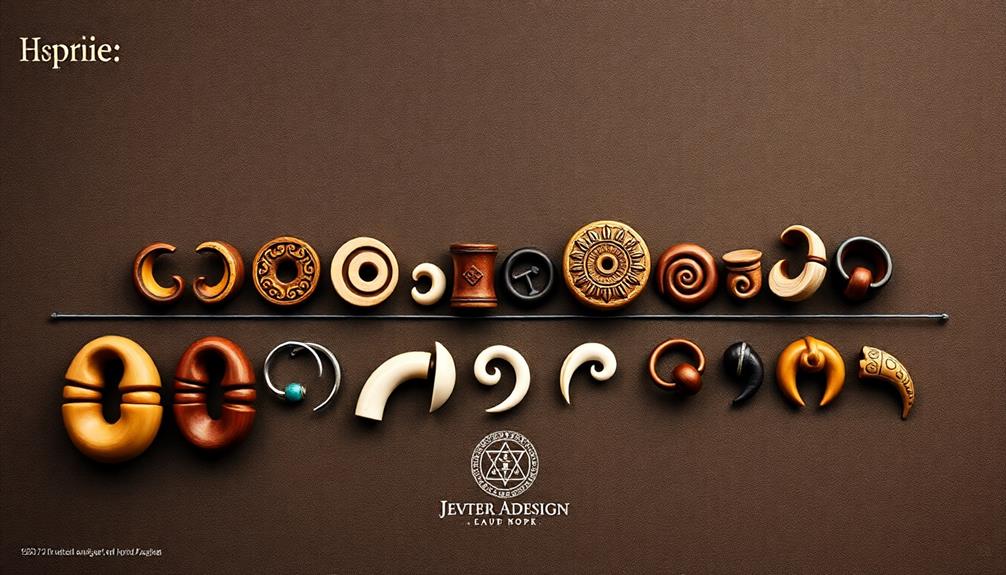
Stretching earlobes is an ancient practice that employs a variety of traditional techniques and materials, reflecting cultural heritage and identity. Throughout history, different civilizations have developed unique methods for ear stretching.
The ancient Egyptians, for instance, used a technique known as dead stretching, where weights or jewelry gradually elongated the earlobes over time. Archaeological findings, such as those related to King Tutankhamun, provide evidence of this practice.
In East Africa, the Maasai tribe utilized sharp objects and natural lubricants to facilitate their ear modifications, showcasing their distinctive cultural approach.
Other civilizations, like the Etruscans, employed studs attached to chains as a means of stretching, highlighting the diversity of techniques across different regions.
The materials used in these traditional techniques varied considerably. Organic materials like jade and wood were common choices, while metals also played a role in the creation of ear gauges.
These materials not only served practical purposes in the body modification process but also reflected the cultural significance and artistic expression of the societies that practiced ear stretching.
Each method demonstrates a rich tapestry of history and identity tied to the art of stretched earlobes.
Evolution of Modern Practices
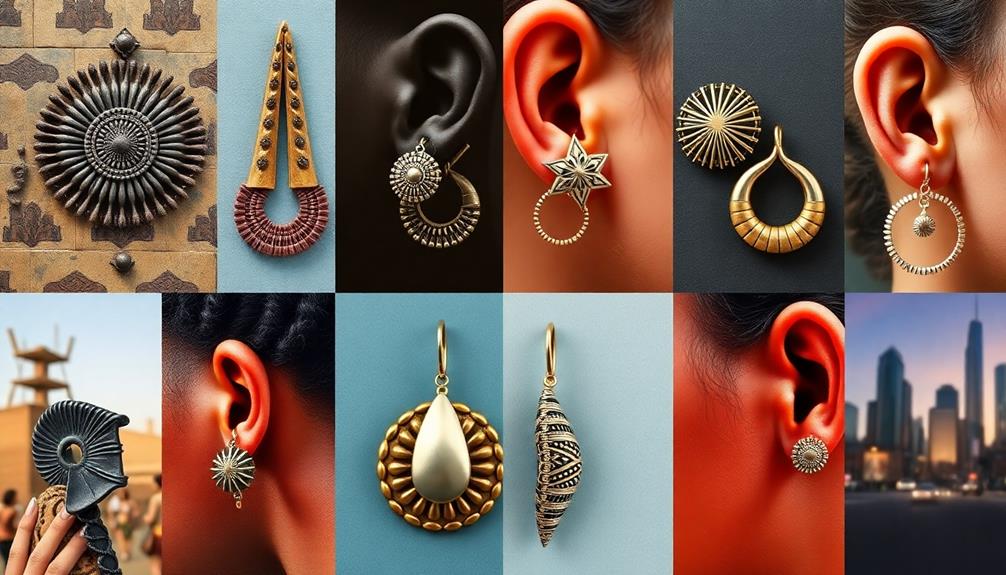
Modern ear stretching practices focus on gradual methods, using tapers and specialized kits to guarantee safety and minimize injury.
You'll find that the introduction of biocompatible materials like silicone has revolutionized comfort and health standards in the community.
With increased awareness of aftercare, enthusiasts now enjoy a more informed approach to ear stretching that prioritizes both aesthetics and well-being.
Modern Techniques and Tools
As the popularity of ear gauges has surged, techniques and tools have evolved considerably to prioritize safety and comfort. Gone are the days of forced methods; today, modern techniques emphasize controlled stretching.
You can now access ear stretching kits designed specifically with safety in mind, making the process smoother and more enjoyable.
Here are some key advancements:
- Gradual Stretching: Using tapers and specialized tape, the risk of injury is considerably reduced.
- Biocompatible Materials: Materials like silicone, acrylic, and implant-grade stainless steel are commonly used for ear gauges, enhancing comfort and minimizing allergic reactions.
- Improved Aftercare: New products, including organic oils and antiseptics, help reduce infection risks and promote healing during the stretching process.
- User-Friendly Tools: Ear stretching kits are designed to make the process accessible to everyone, regardless of experience.
- Art and Science Fusion: The practice has evolved into a blend of aesthetics and health, reflecting advancements in knowledge and technique.
Health and Safety Standards
The evolution of practices surrounding ear gauges has led to a stronger focus on health and safety standards. Today, gradual stretching techniques are emphasized to minimize the risks of tearing and blowouts, guaranteeing you can enjoy your gauges safely.
The introduction of biocompatible materials, like implant-grade stainless steel, silicone, and acrylic, has greatly reduced allergic reactions and skin irritations associated with ear gauge jewelry.
Proper aftercare is essential in preventing infections and complications during the stretching process. Regular cleaning and moisturizing can make a big difference in maintaining healthy piercings.
Specialized stretching kits and tools, including tapers and tunnels, allow you to safely increase the size of your piercings at a controlled pace, further enhancing your safety.
Additionally, educational resources and community support networks play an important role in guiding newcomers on safe stretching practices. By informing you about potential risks and proper techniques, these resources help guarantee a positive experience.
With this focus on health and safety, you can confidently embrace the art of ear gauging while minimizing the risks involved.
Myths and Misunderstandings
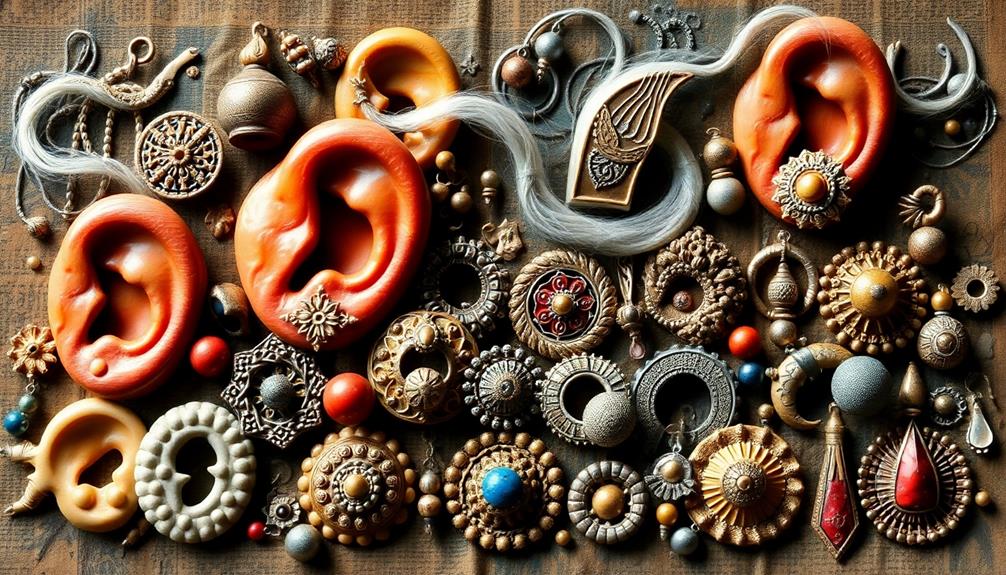
Debunking myths surrounding ear gauges can help you navigate the world of body modification with a clearer perspective.
You'll encounter various misconceptions that can cloud your understanding of ear stretching and its significance. Here are some common myths:
- Permanent Damage: Many think ear stretching always results in irreversible harm, but with proper care, downsizing is often possible.
- Gauge Size Superiority: There's a belief that larger gauges are better, but size is a personal choice reflecting your unique style.
- Modern Trend: Some assume ear stretching is new, while it actually dates back thousands of years in ancient cultures.
- Rebellion Association: Many link ear stretching to rebellion, yet it holds cultural and spiritual significance in societies like the Maasai and Mursi.
- Exaggerated Health Risks: Potential risks like tears and infections are often overstated; educated practices can minimize these concerns.
Understanding these misconceptions allows you to appreciate the cultural roots and traditional practices tied to ear gauges, ultimately empowering your personal choice in body modification.
Contemporary Trends and Influences
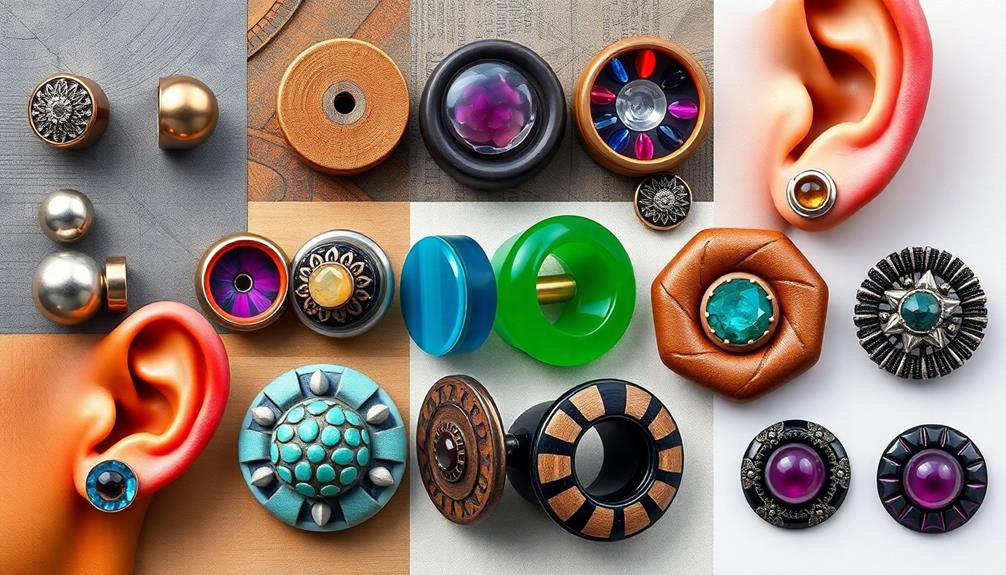
Today, ear stretching isn't just about tradition; it's a canvas for personal expression and aesthetic choices.
You see celebrities like Scarlett Johansson and T-Pain embracing this trend, which adds to its cultural significance and wider acceptance.
With social media amplifying these influences, it's easier than ever to explore and celebrate diverse styles in ear gauges.
Aesthetic Choices Today
Ear gauges' appeal has evolved dramatically, reflecting a unique blend of tradition and modern aesthetics. Today, you'll find a vibrant array of styles that cater to individual tastes and aspirations, influenced by social media and counterculture movements. Many people choose ear gauges not just for body modification but as a powerful form of self-expression.
Here are some contemporary trends in ear gauge aesthetics:
- Unique designs: Bold colors and intricate patterns dominate the scene.
- Minimalist designs: Simple, understated pieces appeal to those who prefer subtlety.
- Organic materials: Wood, stone, and other natural elements are popular for their comfort and eco-friendliness.
- Cultural influences: Various cultures inspire designs, showcasing a rich tapestry of global artistry.
- Social media impact: Influencers and communities share their styles, encouraging wider acceptance and creativity.
With celebrities like Scarlett Johansson and T-Pain shedding light on ear stretching, these aesthetic choices have gained visibility.
The availability of high-quality materials guarantees that you can enjoy both style and safety in your body modification journey.
Cultural Significance Revisited
Cultural significance surrounding ear stretching reflects a rich tapestry of history and modern identity. Today, ear stretching has evolved into a prominent form of body modification, bridging traditional practices with contemporary trends. Since the 1990s, there's been a resurgence in ear stretching, fueled by counterculture movements that embrace self-expression and individuality.
You might notice that modern materials used in ear gauges have greatly improved, with options like biocompatible metals and synthetic materials prioritizing comfort and safety while still making a fashion statement. This evolution allows you to enjoy the aesthetic appeal of ear stretching without compromising on health.
Moreover, as cultural appreciation grows, many individuals respectfully adopt traditional ear stretching practices. They acknowledge the historical significance behind these ancient traditions, merging them with their personal narratives.
This blend of the past and present enables you to express your unique style while honoring the deep-rooted customs that shaped this body modification. Ultimately, ear stretching today isn't just a trend; it's a reflection of your identity, a celebration of history, and an avenue for self-expression.
Celebrity Influence on Trends
With the rise of social media, celebrity influence on fashion trends—including ear stretching—has never been stronger. Public figures like Scarlett Johansson and T-Pain have played pivotal roles in bringing ear gauges into mainstream fashion. Their visibility on platforms like Instagram and Twitter has sparked a dialogue around body modification as a form of personal expression.
Consider these ways celebrities shape the trend:
- Showcasing ear gauges at red carpet events
- Posting about their body modification journeys online
- Participating in counterculture movements through their art
- Inspiring fans to adopt similar styles
- Normalizing larger gauge sizes in contemporary culture
As musicians and artists continue to influence trends, ear stretching has experienced a resurgence since the 1990s, celebrated for its individuality.
The endorsement from international icons transforms ear gauges from a niche practice into a celebrated form of self-expression. The collective visibility of these celebrities helps bridge the gap between alternative lifestyles and mainstream acceptance, making ear stretching not just a trend but a powerful statement of identity.
Health and Safety Considerations
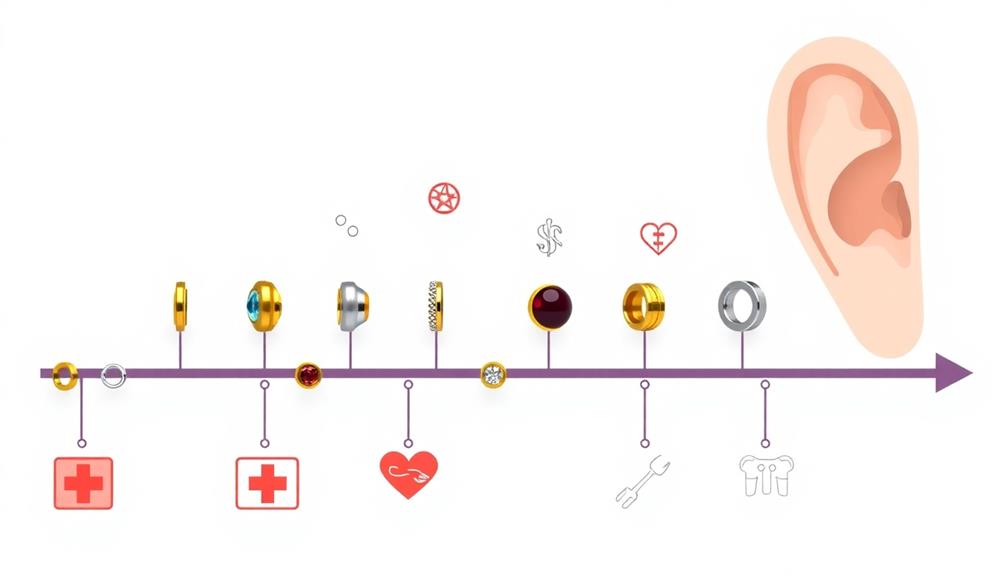
When it comes to stretching your ears, health and safety considerations are paramount for a successful experience. Proper aftercare is vital to prevent infections; make sure to clean the area with saline solution and avoid touching your stretched ears with unwashed hands.
Using gradual stretching techniques, like tapers or increasing gauge sizes slowly, minimizes the risk of tearing and promotes healthier healing.
Choosing jewelry made from biocompatible materials, such as surgical stainless steel, titanium, or glass, can greatly reduce the likelihood of allergic reactions and irritation.
It's important to be aware of potential risks, including blowouts—where the skin tears and pushes out the jewelry—and keloids, which are raised scars. This awareness underscores the significance of informed decision-making and careful monitoring during the stretching process.
Consulting with professionals in body modification can provide valuable guidance on safe stretching practices and appropriate materials. Their expertise will help you navigate the process effectively, ensuring a positive experience while minimizing risks.
Personal Motivations for Ear Gauging
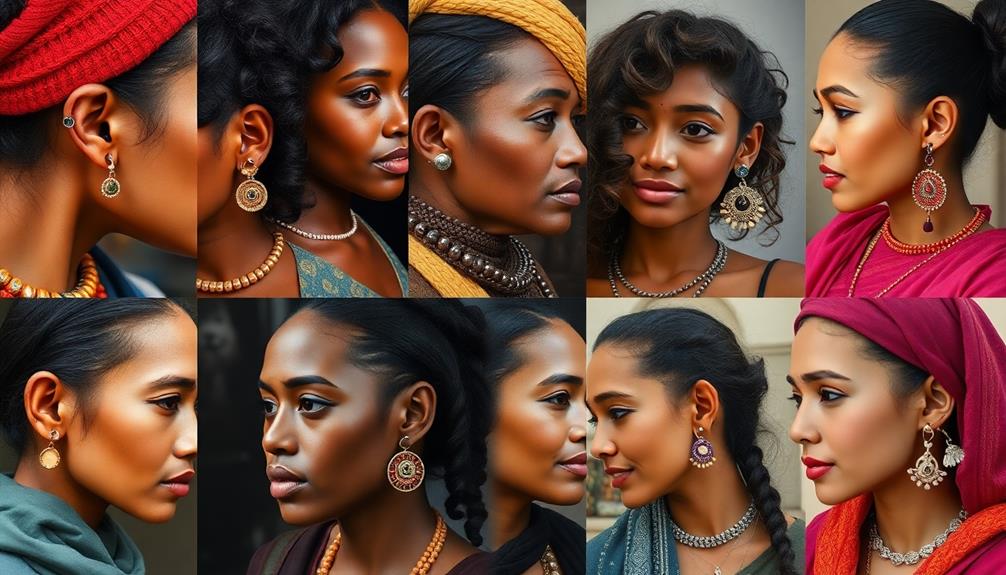
Ear gauging serves as a powerful form of personal expression, allowing you to showcase your individuality through unique styles and sizes of jewelry. Many people choose this practice for various reasons that resonate deeply with their identities:
- Cultural Heritage: Connect with your ancestry and honor traditional practices observed in ancestral tribes.
- Spiritual Symbolism: View ear gauging as a rite of passage, embodying beliefs related to wisdom and personal growth.
- Counterculture Movements: Embrace rebellion against societal norms, making a statement that reflects your individuality.
- Contemporary Fashion: Align with current trends as celebrities and influencers showcase ear gauging in their styles.
- Unique Identities: Celebrate your distinct aesthetic preferences, making your ear jewelry a canvas for self-expression.
Whether you're motivated by the desire to connect with your roots or simply to express your unique style, ear gauging allows for a diverse range of meanings.
Each choice in size and style becomes a reflection of who you are, making this practice not just about appearance, but about embodying your personal journey and values.
Frequently Asked Questions
What Are the Origins of Gauged Ears?
The origins of gauged ears trace back thousands of years, with ancient cultures using stretching to signify status, spirituality, and identity. You'll find evidence in various civilizations, showcasing the practice's deep-rooted cultural significance.
Did Aztecs Wear Gauges?
Absolutely, Aztecs adorned their ears with amazing gauges, showcasing status and sophistication. They crafted colorful creations from stone, wood, and metals, reflecting their identity while enhancing their cultural significance and social standing in society.
Did Native Americans Gauge Their Ears?
Yes, Native Americans did gauge their ears. Many tribes practiced ear stretching for various reasons, including social status and spiritual beliefs, using materials like bone, wood, and stone to express their cultural identity.
What Do Ear Gauges Symbolize?
Ear gauges symbolize personal identity and cultural significance. They can represent rebellion, maturity, or beauty, depending on size and design. Your choice reflects your beliefs, lifestyle, and connections to various communities and trends.
Conclusion
In exploring the evolution of ear gauges, you've uncovered a fascinating fusion of fashion and cultural significance. From ancient practices to modern trends, ear stretching showcases a stunning spectrum of self-expression. As you consider your own journey, remember the rich history and health considerations that accompany this art. Embrace your unique style, celebrate the stories behind the gauges, and continue the conversation about this enthralling custom—where personal passion meets profound tradition.

